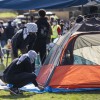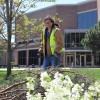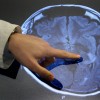

This Chicago doctor worked in a Gaza hospital. Here’s what she saw.
Dr. Tammy Abughnaim recently returned from a medical aid trip to Gaza. When it came time to leave, she says she begged to stay with her patients.
In her emergency department in a Gaza hospital, Dr. Tammy Abughnaim said there was just one ventilator. Throughout her shifts, she treated patients with injuries from bombs, rocket strikes and gunfire — without the medical resources needed.
Dr. Abughnaim normally works as an emergency physician on the South Side of Chicago. But in March, she spent two weeks living and working in Al-Aqsa Hospital as part of a World Health Organization team.
She said there is nothing that compares to the emergency rooms in Gaza.
“You’re doing resuscitations and procedures on children who are laying on the floor, and you don’t have the equipment to be able to effectively treat them,” Dr. Abughnaim said. “On any given day, you have to basically decide who lives and dies.”
Originally Dr. Abughnaim meant to travel to Gaza for a much different reason — to teach ultrasound skills to physicians there. But she was scheduled to go in October of last year.
That changed when Hamas attacked Israel on Oct. 7, killing 1,200 people, according to estimates from the Israeli military. Since then, Israel’s assault on Gaza has killed over 33,000 Palestinians, according to the Gaza Health Ministry.
As she watched crisis after crisis from afar, Dr. Abughnaim said she wanted to provide medical aid.
“I felt a calling to be able to provide relief to both the people of Gaza and the healthcare workers of Gaza,” Dr. Abughnaim said. “You cannot see these health care workers who have been living and working in these conditions for six months and not feel a kinship to them.”
At least 700 humanitarian aid workers and medical staff have been killed in Gaza, according to combined data from the United Nations and the Gaza Health Ministry.
Despite the risk, Dr. Abughnaim decided to go. Knowing that her parents would worry, she told them that she would be working as a physician in Egypt, helping evacuees from Gaza. Her mother found out she was in Deir al-Balah — a city in the middle of the strip — from a video of her treating patients that made its way onto social media.
She said she has apologized for fudging the truth. But she does not regret going.
Reset host Sasha-Ann Simons recently sat down with Dr. Abughnaim. Here are highlights from the conversation.
Once they enter the hospital, what sorts of challenges do patients face?
These hospitals are functioning as a combination of several things. One is a hospital, providing medical services to patients. The other is a shelter. There are patients in every square inch of these hospitals…
After a mass casualty incident – either an airstrike or a drone strike, or shelling or tanks running people over – we would receive patients in gushes. It would be 20, 30, 40 patients at a time. Sorting through those patients and treating them was one challenge. And then the other is: “What do you do with people who have nowhere else to go?” …
After we finished treating their injuries, (patients)… would park their mattresses in the hallway or another ward. And it’s just hallways full of people. I mean, you can trip over people just walking on your way from the ER.
You mostly treated children. How did that feel?
It’s traumatizing. It’s still very difficult for me to talk about. These children had parents who had hopes for them… A lot of times, the children that we were seeing were recently orphaned – every member of their family had died. It’s difficult as an ER doctor to divorce yourself from that context.
So I would see children whose homes had just been hit by an airstrike, whose entire family had just died. We would have to tell them that they were now orphans, that there was nobody in the world left for them.
On top of that, we were doing very painful things to them. You know, there were procedures that needed to be done like chest tubes, amputations, things of that nature. And there is nobody to comfort these children. So we become their comforters, we become their temporary parents. But after our job is done, we can’t do that anymore. And there is nobody else to take on that role.
What kinds of questions would patients and health care workers ask you?
Every person who found out that I was from the United States would ask me, “Doctor, do you know when the war is going to end?”
In their mind, coming from the United States, I must have some information about the trajectory of this war…It’s heartbreaking to hear that question over and over and over again, and not have a satisfactory answer, especially when I know that American-made weapons are being utilized against them…
They would ask me: “Do people see us? Do people outside of the Gaza Strip see what is happening to us? Do they see the videos of our dead children? Do they see the videos of destruction?” And I would tell them, “Yes, millions of people are seeing those videos, and they’re seeing those images, and there are protests, and there are movements.”
And they would say, “Well, why hasn’t it stopped then? How can all of these people see what’s going on, and nobody is up in arms about it? How can people let this go on for six months?”
I don’t have an answer for that.
Being confronted with that question was one of the hardest things about being in the Gaza Strip, because you want to tell people that everything is going to be okay. And I know that it is not.
How did it feel to have to leave?
I did not want to leave. It is very difficult to leave people who you know are in danger. And I kept begging my organization to keep me. I said, “Give me one more week. Give me two more weeks. There is so much work to be done. I can’t leave these people.”
That was declined for safety reasons and logistical reasons. But I had formed relationships with the people that I’d met. I’d formed friendships with the doctors and the nurses, with the people who were displaced living in the hallways, with the kids.
I could not fathom going back to my life in the United States, knowing that I might sometime receive a phone call saying that, “Everyone you know is dead.” And I think that’s still the most difficult part. It’s what haunts me every hour of the day.
Do you think you’ll go back?
Yes, absolutely. I have every intention of going back. How can I see what I have seen and know that I can relieve some measure of suffering and not want to go back?
This interview has been edited for length and clarity.
More From
Reset with Sasha-Ann Simons


This Chicago doctor worked in a Gaza hospital. Here’s what she saw.
Dr. Tammy Abughnaim recently returned from a medical aid trip to Gaza. When it came time to leave, she says she begged to stay with her patients.
In her emergency department in a Gaza hospital, Dr. Tammy Abughnaim said there was just one ventilator. Throughout her shifts, she treated patients with injuries from bombs, rocket strikes and gunfire — without the medical resources needed.
Dr. Abughnaim normally works as an emergency physician on the South Side of Chicago. But in March, she spent two weeks living and working in Al-Aqsa Hospital as part of a World Health Organization team.
She said there is nothing that compares to the emergency rooms in Gaza.
“You’re doing resuscitations and procedures on children who are laying on the floor, and you don’t have the equipment to be able to effectively treat them,” Dr. Abughnaim said. “On any given day, you have to basically decide who lives and dies.”
Originally Dr. Abughnaim meant to travel to Gaza for a much different reason — to teach ultrasound skills to physicians there. But she was scheduled to go in October of last year.
That changed when Hamas attacked Israel on Oct. 7, killing 1,200 people, according to estimates from the Israeli military. Since then, Israel’s assault on Gaza has killed over 33,000 Palestinians, according to the Gaza Health Ministry.
As she watched crisis after crisis from afar, Dr. Abughnaim said she wanted to provide medical aid.
“I felt a calling to be able to provide relief to both the people of Gaza and the healthcare workers of Gaza,” Dr. Abughnaim said. “You cannot see these health care workers who have been living and working in these conditions for six months and not feel a kinship to them.”
At least 700 humanitarian aid workers and medical staff have been killed in Gaza, according to combined data from the United Nations and the Gaza Health Ministry.
Despite the risk, Dr. Abughnaim decided to go. Knowing that her parents would worry, she told them that she would be working as a physician in Egypt, helping evacuees from Gaza. Her mother found out she was in Deir al-Balah — a city in the middle of the strip — from a video of her treating patients that made its way onto social media.
She said she has apologized for fudging the truth. But she does not regret going.
Reset host Sasha-Ann Simons recently sat down with Dr. Abughnaim. Here are highlights from the conversation.
Once they enter the hospital, what sorts of challenges do patients face?
These hospitals are functioning as a combination of several things. One is a hospital, providing medical services to patients. The other is a shelter. There are patients in every square inch of these hospitals…
After a mass casualty incident – either an airstrike or a drone strike, or shelling or tanks running people over – we would receive patients in gushes. It would be 20, 30, 40 patients at a time. Sorting through those patients and treating them was one challenge. And then the other is: “What do you do with people who have nowhere else to go?” …
After we finished treating their injuries, (patients)… would park their mattresses in the hallway or another ward. And it’s just hallways full of people. I mean, you can trip over people just walking on your way from the ER.
You mostly treated children. How did that feel?
It’s traumatizing. It’s still very difficult for me to talk about. These children had parents who had hopes for them… A lot of times, the children that we were seeing were recently orphaned – every member of their family had died. It’s difficult as an ER doctor to divorce yourself from that context.
So I would see children whose homes had just been hit by an airstrike, whose entire family had just died. We would have to tell them that they were now orphans, that there was nobody in the world left for them.
On top of that, we were doing very painful things to them. You know, there were procedures that needed to be done like chest tubes, amputations, things of that nature. And there is nobody to comfort these children. So we become their comforters, we become their temporary parents. But after our job is done, we can’t do that anymore. And there is nobody else to take on that role.
What kinds of questions would patients and health care workers ask you?
Every person who found out that I was from the United States would ask me, “Doctor, do you know when the war is going to end?”
In their mind, coming from the United States, I must have some information about the trajectory of this war…It’s heartbreaking to hear that question over and over and over again, and not have a satisfactory answer, especially when I know that American-made weapons are being utilized against them…
They would ask me: “Do people see us? Do people outside of the Gaza Strip see what is happening to us? Do they see the videos of our dead children? Do they see the videos of destruction?” And I would tell them, “Yes, millions of people are seeing those videos, and they’re seeing those images, and there are protests, and there are movements.”
And they would say, “Well, why hasn’t it stopped then? How can all of these people see what’s going on, and nobody is up in arms about it? How can people let this go on for six months?”
I don’t have an answer for that.
Being confronted with that question was one of the hardest things about being in the Gaza Strip, because you want to tell people that everything is going to be okay. And I know that it is not.
How did it feel to have to leave?
I did not want to leave. It is very difficult to leave people who you know are in danger. And I kept begging my organization to keep me. I said, “Give me one more week. Give me two more weeks. There is so much work to be done. I can’t leave these people.”
That was declined for safety reasons and logistical reasons. But I had formed relationships with the people that I’d met. I’d formed friendships with the doctors and the nurses, with the people who were displaced living in the hallways, with the kids.
I could not fathom going back to my life in the United States, knowing that I might sometime receive a phone call saying that, “Everyone you know is dead.” And I think that’s still the most difficult part. It’s what haunts me every hour of the day.
Do you think you’ll go back?
Yes, absolutely. I have every intention of going back. How can I see what I have seen and know that I can relieve some measure of suffering and not want to go back?
This interview has been edited for length and clarity.










